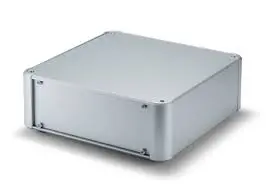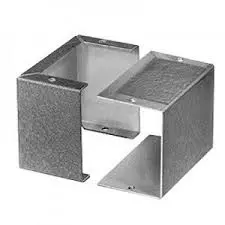What are Sheet Metal Cases used for?
2025-02-25 14:50:24
Sheet metal cases are versatile and durable enclosures widely used across various industries. These cases provide protection, organization, and functionality for a multitude of applications. From electronics and automotive to aerospace and consumer goods, sheet metal cases offer robust solutions for housing components, equipment, and products. This blog explores the diverse uses of sheet metal cases, their advantages, and the industries that rely on them. We'll delve into the manufacturing processes, design considerations, and the role of sheet metal cases in modern engineering and product development.

Applications of Sheet Metal Cases
Electronics and Telecommunications
In the electronics and telecommunications sector, sheet metal cases play a crucial role in protecting sensitive equipment. These cases house circuit boards, power supplies, and communication devices, shielding them from electromagnetic interference (EMI) and environmental factors. Sheet metal cases for electronics often feature ventilation slots, cable management systems, and modular designs to accommodate various components. They're commonly used in server racks, network switches, and industrial control panels, providing both functionality and aesthetic appeal.
Automotive and Transportation
The automotive industry relies heavily on sheet metal cases for various applications. These cases are used to enclose engine control units (ECUs), infotainment systems, and other electronic modules within vehicles. Sheet metal cases in automotive applications must withstand vibration, temperature fluctuations, and potential exposure to fluids. They're designed to meet stringent safety and reliability standards while offering easy access for maintenance and repairs. Additionally, sheet metal cases are used in the transportation sector for ticketing machines, GPS units, and communication systems in buses, trains, and aircraft.
Medical and Healthcare Equipment
In the medical field, sheet metal cases are essential for housing diagnostic equipment, monitoring devices, and therapeutic instruments. These cases must meet strict hygiene standards and be easy to clean and sterilize. Sheet metal cases for medical applications often feature smooth surfaces, rounded edges, and corrosion-resistant materials like stainless steel. They're used in portable medical devices, laboratory equipment, and hospital room fixtures, providing both protection and a professional appearance.
Advantages of Sheet Metal Cases
Durability and Protection
Sheet metal cases are famous for their remarkable toughness, giving vigorous security against physical harm, vibrations, and different natural components. Their solid development makes them exceedingly compelling in shielding touchy gear from impacts, dampness, clean, and temperature variances. Whether utilized in mechanical settings, open air situations, or high-traffic ranges, sheet metal cases guarantee that their substance stay secure and operational indeed beneath extraordinary conditions. This level of assurance is fundamental for keeping up the usefulness and astuteness of important components in challenging situations.
Customization and Flexibility
One of the standout points of interest of sheet metal cases is the tall degree of customization they offer. Producers can plan cases in different shapes, sizes, and setups to meet the particular needs of diverse applications. Custom set patterns for ports, ventilation, and mounting focuses can be effortlessly joined, as well as custom fitted wraps up to suit branding or natural necessities. This adaptability makes sheet metal cases an perfect choice for both standard items and specialized applications, where exactness and interesting highlights are fundamental for ideal execution.
Cost-Effectiveness and Scalability
Sheet metal cases are regularly a cost-effective choice for producers, especially for medium to huge generation runs. The well-established fabricating procedures, such as stamping, bowing, and welding, are exceedingly mechanized, making a difference to decrease labor and fabric costs. Furthermore, the adaptability of sheet metal generation implies that producers can effortlessly alter the volume of cases being delivered without the require for noteworthy changes to tooling or forms. This cost-efficiency, coupled with adaptability, makes sheet metal cases an appealing choice for businesses of all sizes, from new businesses to large-scale mechanical operations.

Manufacturing Processes and Design Considerations
Fabrication Techniques
The manufacturing of sheet metal cases involves several key processes. Cutting is typically done using laser or plasma cutting machines, ensuring precision and efficiency. Bending and forming operations shape the metal into the desired configuration, often using computer-controlled press brakes. Welding techniques, such as spot welding or TIG welding, join components together, creating strong and seamless connections. Surface finishing processes, including powder coating, anodizing, or plating, provide corrosion resistance and aesthetic appeal. Advanced manufacturing facilities, like those at RUIRUI, employ robotic production lines and state-of-the-art equipment to ensure high-quality output and consistent results.
Material Selection
Choosing the right material for sheet metal cases is crucial to their performance and longevity. Common materials include mild steel, stainless steel, aluminum, and galvanized steel. Each material offers different properties in terms of strength, weight, corrosion resistance, and cost. For example, stainless steel is often chosen for its excellent corrosion resistance and durability, making it ideal for outdoor or marine applications. Aluminum is preferred when lightweight design is a priority, such as in portable devices or aerospace components. The selection of material depends on factors such as the intended use, environmental conditions, and regulatory requirements.
Design for Manufacturability
Effective design of sheet metal cases requires a thorough understanding of manufacturing processes and limitations. Designers must consider factors such as bend radii, minimum flange lengths, and hole-to-edge distances to ensure the case can be produced efficiently and reliably. Incorporating features like self-clinching fasteners, knock-outs for cable entry, and interlocking tabs can enhance the functionality and ease of assembly. 3D modeling and simulation software play a crucial role in optimizing designs for manufacturability, allowing engineers to identify potential issues before production begins. This approach helps reduce costs, improve quality, and accelerate time-to-market for sheet metal case products.
Conclusion
Sheet metal cases are indispensable in modern manufacturing, offering durability, flexibility, and cost-effectiveness across numerous industries. From electronics to healthcare, these versatile enclosures continue to evolve, meeting the changing demands of technology and design. As manufacturing processes advance, sheet metal cases will undoubtedly play a crucial role in protecting and housing the products of tomorrow. If you want to get more information about this product, you can contact us at info@qdkshd.com.
References
1. "Sheet Metal Fabrication: Techniques and Applications" by David Gingery
2. "Design for Manufacturability Handbook" by James G. Bralla
3. "Sheet Metal Forming Processes and Die Design" by Vukota Boljanovic
4. "Manufacturing Engineering and Technology" by Serope Kalpakjian and Steven R. Schmid
5. "Materials Selection in Mechanical Design" by Michael F. Ashby
6. "Industrial Design: Materials and Manufacturing Guide" by Jim Lesko
Send Inquiry
You may like
